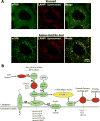Beyond indigestion: emerging roles for lysosome-based signaling in human disease
- PMID: 25950843
- PMCID: PMC4529762
- DOI: 10.1016/j.ceb.2015.04.014
Beyond indigestion: emerging roles for lysosome-based signaling in human disease
Abstract
Lysosomes are becoming increasingly recognized as a hub that integrates diverse signals in order to control multiple aspects of cell physiology. This is illustrated by the discovery of a growing number of lysosome-localized proteins that respond to changes in growth factor and nutrient availability to regulate mTORC1 signaling as well as the identification of MiT/TFE transcription factors (MITF, TFEB and TFE3) as proteins that shuttle between lysosomes and the nucleus to elicit a transcriptional response to ongoing changes in lysosome status. These findings have been paralleled by advances in human genetics that connect mutations in genes involved in lysosomal signaling to a broad range of human illnesses ranging from cancer to neurological disease. This review summarizes these new discoveries at the interface between lysosome cell biology and human disease.
Copyright © 2015 Elsevier Ltd. All rights reserved.
Figures


References
-
- Kollmann K, Uusi-Rauva K, Scifo E, Tyynela J, Jalanko A, Braulke T. Cell biology and function of neuronal ceroid lipofuscinosis-related proteins. Biochim Biophys Acta. 2013;1832(11):1866–1881. - PubMed
Publication types
MeSH terms
Substances
Grants and funding
LinkOut - more resources
Full Text Sources
Other Literature Sources

